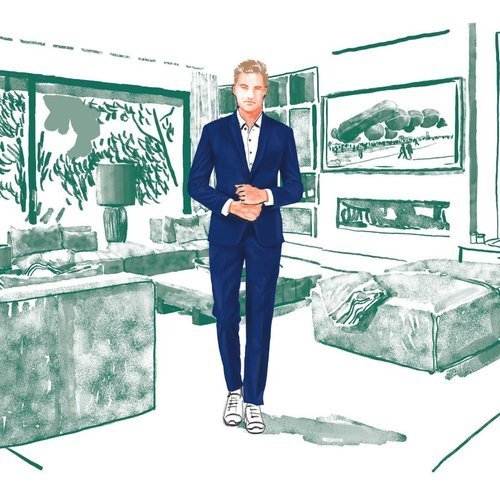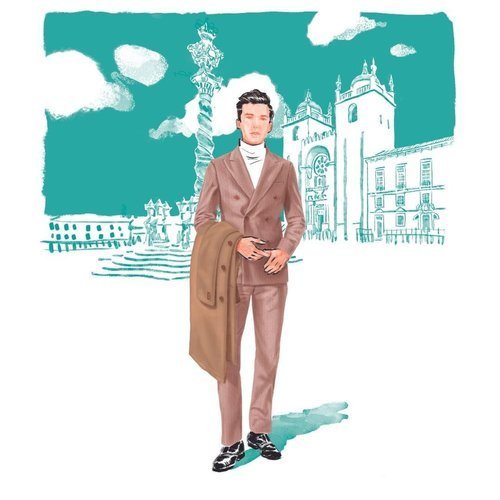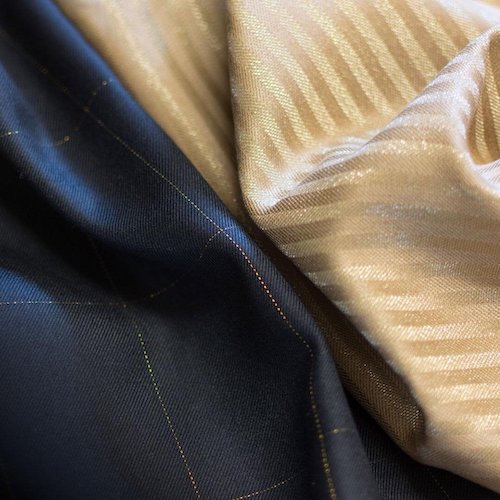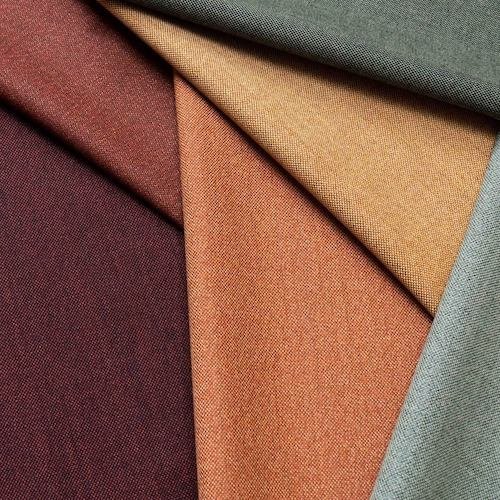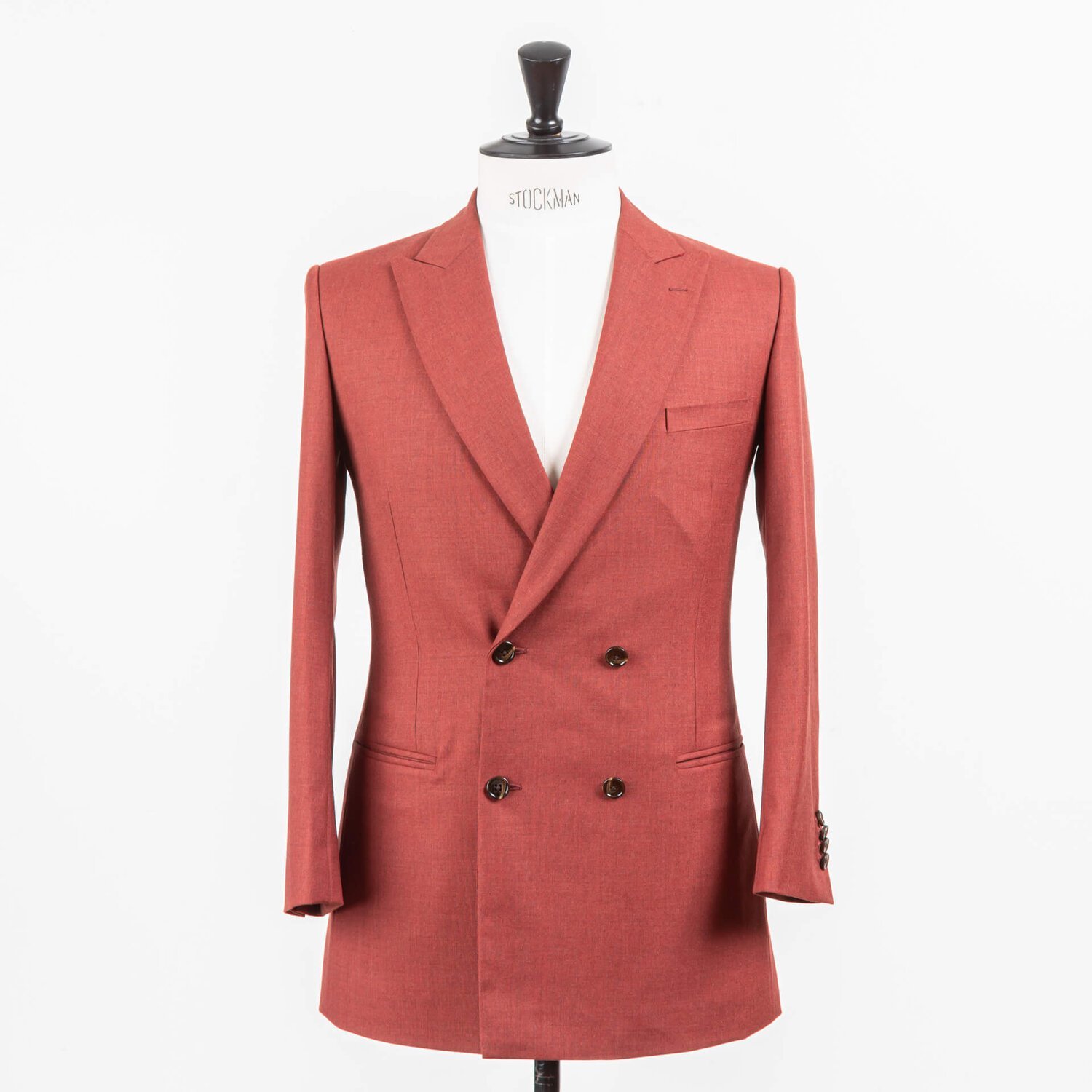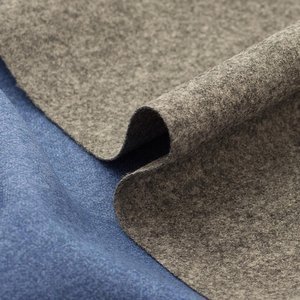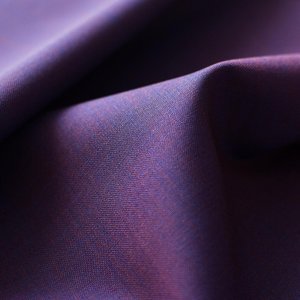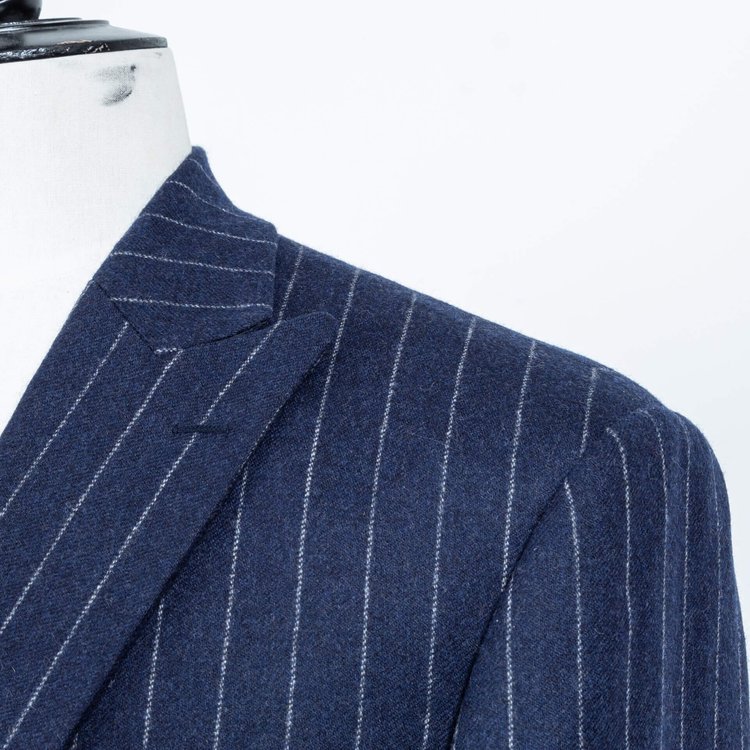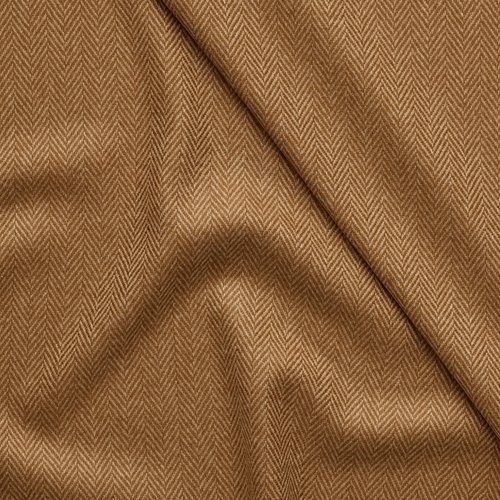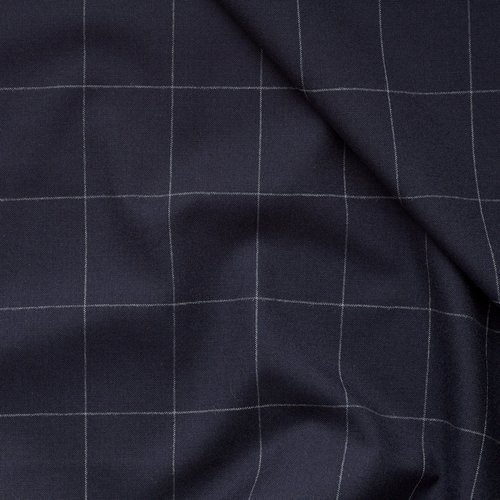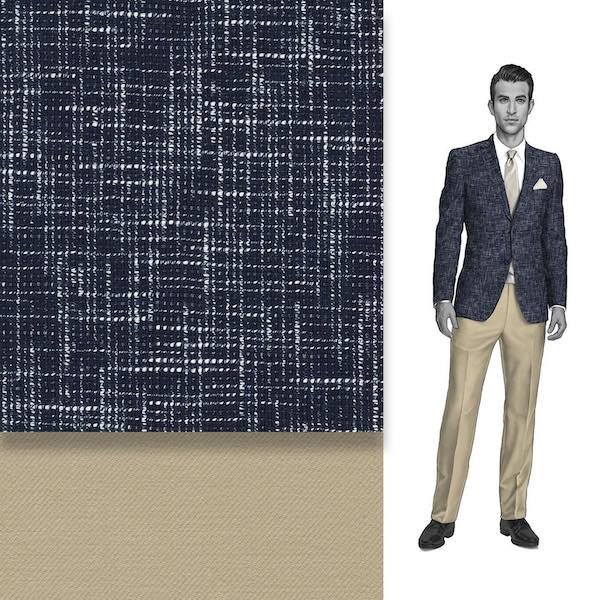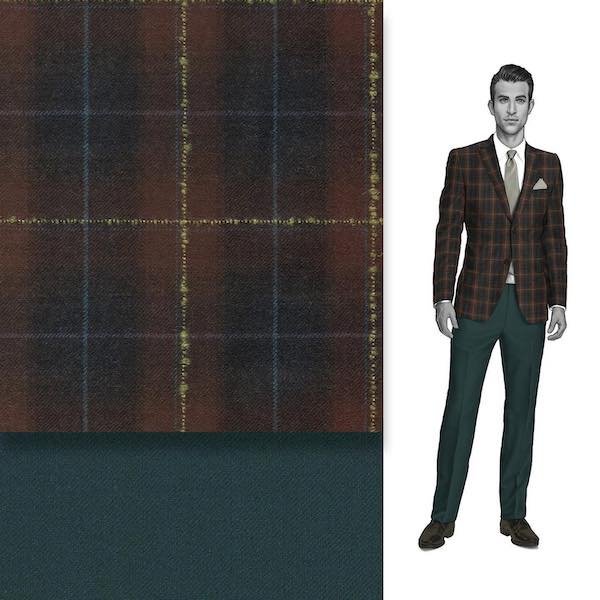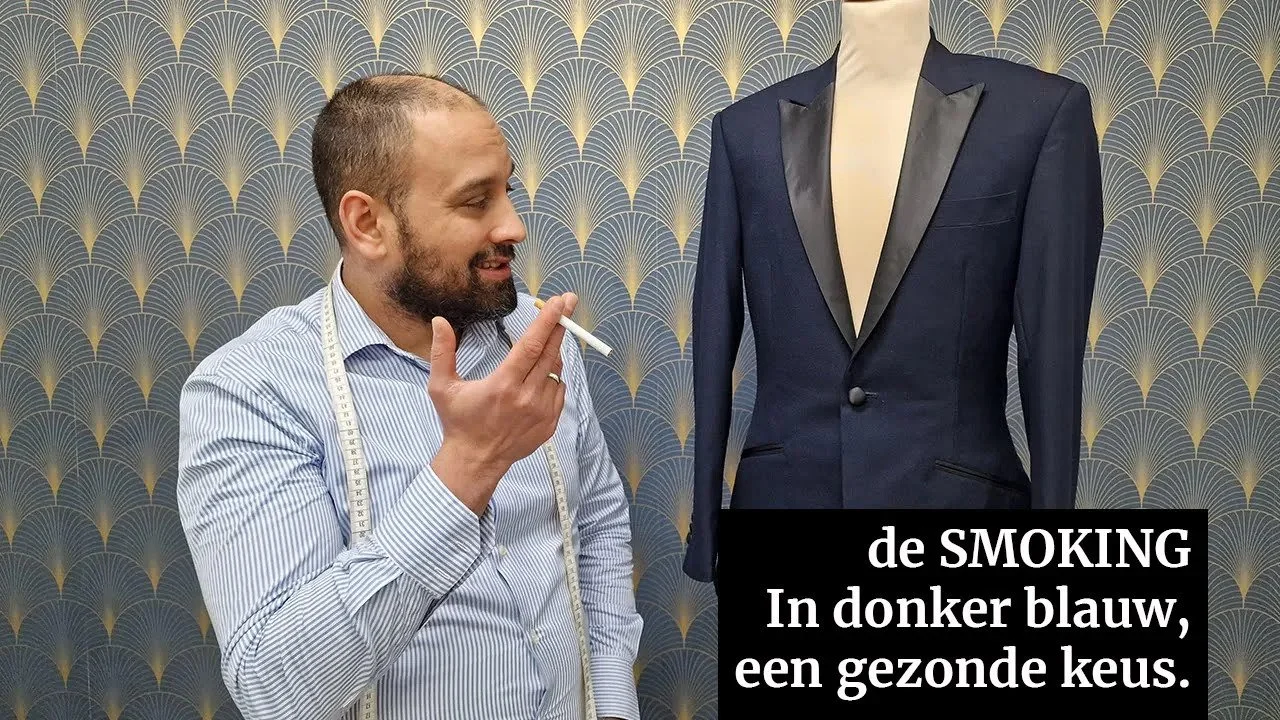Points to consider when choosing the fabric for your wedding suit
1. How do you choose the right fabric for your wedding suit?
2. Fabrics evoke associations and emotions.
3. What should you pay attention to when choosing a fabric for your suit?
4. Which Fabric Weaves and Patterns are suitable for the groom's suit?
5. What types of wedding suit styles are there?
6. Wedding suit: How do you combine fabrics?
7. The benefits of the right wedding suit fabric?
You might think that, for example, all blue and grey suits look the same. But when you look further, you discover many more details than you expected. And you suddenly discover that you have completely different wishes when it comes to the material than you had suspected. Consider the colour, the texture, the structure, the way of weaving, the pattern and the type of material.
Choosing the right fabric for your wedding suit means that you know exactly what your wishes are and what to look for. With this blog about wedding suit fabrics we are happy to help you so that you can consciously choose what suits you best as a groom.
First ask yourself the following questions:
1. What do I want to radiate with my wedding suit?
2. What would this look like?
Then write down your findings and collect visuals of not only wedding suits but also your colour theme and location of the wedding. Also present this to your fiancée and people who know you well for feedback and additions.
You probably already have a certain image of your wedding suit and these questions and answers will help you further visualise this and make it concrete. You can find many images by using Google, Pinterest and/or Instagram.
Whether you have an idea or not, it is time to delve further into fabrics for wedding suits. The choice can be overwhelming, but with a little more knowledge you can easily make your decisions and arrive at a nice selection for your wedding suit. Also don't be afraid to ask for advice and feedback.
The most important point is that you and your partner feel comfortable with it. Then you create the (understated) confidence that comes with a wedding and you are dressed to impress in a natural way.
Also consider the location, dress code and time of year when choosing your wedding suit / wedding clothes. A linen summer suit is less suitable for a winter wedding and a Vintage wedding suit made of Tweed or Flannel is less appropriate for a summer wedding.
Always make sure that you are the center of attention with your wedding clothes and that it complements your partner. Follow your heart and common sense and above all, don't follow fashion alone. Making a outspoken colour or other statement with your wedding suit may seem like a good choice now, but how do you look back on your choice later? Fashion does not age very well. These are classics for a reason and by knowing how to combine well you can twist a classic suit with fabric and give combinations a very personal look. You can often still wear the wedding suit afterwards at different occasions.
It is wise that you weigh the following points and look at these characteristics:
· The colour of your wedding suit
· The type of Material / Fabric of your wedding suit
· The Texture / Structure of your wedding suit
· The Fabric / Pattern of your wedding suit
How to determine the colour of your wedding suit: Colours are personal emotions so fashion is not necessarily what suits you and your wedding. Follow your heart and ultimately choose what you like.
More and more wedding suits are being made in colours other than 'standard' blue. This is because weddings are becoming increasingly personal, such as theme and destination weddings, and the groom sees his suit as an extension of his personality.
You still see a lot of blue, but with a focus on a certain tone and effect. You can create this with the correct use of weaves and patterns in the fabric. A stylish but safe option is a blue wedding suit with a waistcoat or shirt underneath in a different colour.
Always take these points into account when determining the colour of your wedding suit:
· Your skin and hair colour
· Your partner's clothes
· The location, the atmosphere, appearance and temperature
· Theme of your wedding: is it a winter / summer, vintage, casual wedding etc.
Colour provides a visual stimulus and emotional experience. Colour causes a physiological change in your body. Colour influences how we and the wedding guests think, how we feel and how we behave.
What are popular colours for a wedding suit?
You can of course also choose to go for a different colour. Popular colours are green, dark red, pink and also brown. Of course, there are many types of shades of colours and the material, texture and way of weaving also influence the colour and association. So often the colour is a good guideline, but you should not forget the other aspects. Get good advice on this from an employee or tailor who has worked with a variety of materials.
1. Wool
1.1 Summer wool: Summer wool fabrics are fabrics with a weight of < 280 grams. The advantage is that these provide a lightweight wedding suit that breathes well. Pay attention to whether you choose a worsted or high-twist fabric. A worsted remains flexible and a high-twist fabric will feel more crisp. The effect of the lighter weight is that they have less drape, so they fall less tightly and are more likely to show folds and wrinkles.
Click here and watch this video for an impression of Summer wool.
1.2. Heavy Weight Wool: The term heavy weight is a bit misleading. But let's say these are fabrics of >340 grams. Fabrics between 340 and 370 grams always give the best results in terms of fit because of this weight. But they can still look and feel too warm for some grooms. There are also weights of, for example, 310 grams that combine properties of both light and heavier fabrics.
It is therefore best to use the above information as a guideline and not as the truth. Every person reacts differently to fabrics, one person gets warm more quickly than another, for example, and this also determines what type of substance you, unconsciously or consciously, find attractive and what feeling it evokes in you.
2. Linen: Linen fabrics have become increasingly popular in recent years, especially for destination weddings in the sun or for those who want a relaxed summer look at the wedding. Linen has a property that you can either tolerate or not. It wrinkles, the better the quality the more it actually wrinkles. Linen is very light and breathes fantastic and there are many colors available and nowadays also more patterns. Linen is often also chosen for a waistcoat at the wedding to give the suit a nice natural and more casual accent.
3. Wool/Linen or Wool/Linen/Silk:
The blends, mixtures of various fabrics, give extra properties to the fabric as a whole and also ensure that wrinkles are reduced. You still retain the natural relaxed appearance, but you add some other vitamins. The wool ensures that the fabric wrinkles less but also insulates better in colder periods, so you can wear your wedding suit more all season. The silk gives it a nice shine without making the fabric shine too much. Because you use three types of material, you can also create fantastic structure and colour combinations.
4. Bamboo:
A fabric that was only introduced a few years ago but was an instant hit is Bamboo. Why? Bamboo fabrics are soft, light and have a silky look and extremely good moisture-wicking and ventilating properties against odors and it also insulates very well in colder temperatures. So you can wear bamboo from the beginning of spring to the end of autumn. Bamboo fabric is 100% biodegradable and is completely broken down by the soil and sunlight alone. We call that a sustainable wedding suit fabric.
5. Cotton:
Cotton is still widely used for wedding suits, but is less light and breathable than linen, but certainly suitable for the summer. And even for winter, it is advisable to choose a heavier weight that also gives a fuller body to your entire outfit. Cotton is also pleasant to wear, not too soft and not too hard. It retains its shape less than wool but wrinkles much less than linen.
It gives a neat but lively look to your outfit. The more you wear it, the smoother it becomes and it will radiate more, just like leather does. Cotton is often used as a fabric for the trousers of a Tenue de Ville. For trousers it is best to choose a smooth fabric with a plain weave or a beautiful Twill. For a jacket you can use the more striking variants and colors, such as seersucker, corduroy, moleskin or a nice mix.
6. Flannel:
My personal favourite because Flannel is exactly between the classic 'City Suits' (the suit that father and grandfather wore to work) and Casual. So you are still dressed stylishly and distinguishably, but not as if you are going to work. Due to the loose way of weaving, flannel has a lively, full and rich appearance and it is soft and very pleasant to wear. It simply has character and fits in nicely with the wishes of many grooms for a more cool retro, bohemian look. country, vintage or whatever you want to call it to look during the wedding. Many style icons wore it, ranging from Winston Churchill to Gianni Agnelli.
7. Tweed:
We increasingly see tweed as a fabric for wedding suits that are worn in winter and autumn and even more often as a material for a waistcoat when getting married. Tweed is a sturdy woolen fabric that is unfortunately often associated with old-fashioned and classic British. Tweed is the original 'quality fabric' in the land of suit makers, sturdy, durable and easy to wear in damp environments. This is due to its bouncy and hairy texture. Nowadays, tweed is available in every conceivable colour variant and the many colour accents together with the texture make it ideal to combine with other fabrics and also to wear after the wedding as a beautiful business / smart casual piece of clothing.
8. Cashmere:
Cashmere is the wool of a goat and an extremely soft fabric that looks lush and is very comfortable and pleasant to wear. The disadvantage of Cashmere is that it is not durable and is therefore not suitable for trousers. If you like luxury, a jacket or waistcoat in Cashmere can give your wedding a nice, prosperous accent. A frock- or tailcoat, the coat you wear with a Jacquet is also fantastic and radiates enormous wealth. If you do opt for Cashmere, it is advisable to go for a heavier weight, otherwise you will completely lose the fit and it will wear out even faster.
9. Other fabrics or supplying your own fabrics:
There are many more fabrics and fabric mixtures that are used for wedding suits. You can of course also supply your own fabric when you have your wedding suit custom made. For example, we often work with Batik and fabrics from Vlisco, which can give a completely different culturally inspired twist to your clothing.
Materials that are also very special to work with are, for example: Velours / Velvet, Vicuña, Alpaca, Yak wool and the wool of other exotic species. Often very expensive and almost no one can process them, but certainly an option for the groom who appreciates the savoir-faire of fabrics and sartorialism and is really looking for something very exclusive.
10: Fairtrade & Sustainable Fabrics:
Fabrics also have a production chain, so you can also decide whether you find this important. It is of course nice when your suit is made of fabric that has been processed in the best possible way for nature and animals. These types of fabrics will become more and more available in the coming years.
A good example is Marling & Evans who ensure that all their fabrics meet corporate social responsibility requirements. The dyeing, yarns, weaving are done without the use of chemicals and even the packaging is done according to these guidelines, which means there is minimal impact on people and the environment.
When it comes to wedding suits, there is an increasing tendency to choose a fabric with a relaxed look and you can achieve this through the structure / texture of the fabric. You can then work nicely with looser woven fabrics and less tightly spun fibers that therefore appear less stiff.
Big favourites for summer wedding suits are the linen fabrics with wool and/or silk and for winter and autumn wedding suits the Flannel and Tweed fabrics.
Tip: Please note that loosely woven fabrics often lose their shape sooner. So if you have your wedding suit measured precisely, cut to the bone, they may break sooner. So have this measured with 1 to 2 cm extra space, especially on the legs because of the tension that is placed on them when sitting down.
A fabric with structure is also linked to the location of your wedding. A linen suit can be nice for a more casual wedding, but is less appropriate when your bride is dressed in a classic dress and the theme is formal in nature. For example, a Tweed suit with a coarse structure is beautiful when you get married in a Scottish castle.
In the past, wedding suits were mainly made of dark blue and black fabrics with a smooth structure and a small pattern. Patterns were mainly intended to 'break up' the fabric, not to stand out. You can think of a herringbone, birdseye, sharkskin / pick 'n pick or twill.
Now that a wedding suit has truly become an extension of the groom's personality, you see that more pronounced patterns are being used, which, together with the colour and texture of the fabric, give your wedding suit its own look and feel and have more personality. We now see larger patterns and contrasts more often, such as various checkered patterns such as
Window panes
Tartans
Overchecks
Pin stripes
Herringbones (the wider variants)
Tip: Use a small pattern for your jacket and trousers and a larger pattern for your waistcoat. This way you get depth in your outfit and it doesn't become a chaos of all kinds of patterns.
There are 4 types of styles of wedding suits
A suit is often made in 3 pieces in 1 type of fabric. This is often in a dark colour with possibly small personal details. Stylish as a wedding suit, but also an option to wear afterwards. The classic option for a wedding suit that is always good.
The choice for those who want to implement their own wishes completely. Often a 3-piece suit or an outfit where the jacket, trousers and waistcoat can be worn as a set or separately. This in a special colour and material where the model is often less classic. The kind of wedding suit that suits a groom who sees his clothes as an extension of his personal style and taste.
3. Modern / 'Casual' wedding suit.
The jacket and trousers in one type of fabric or a different type of fabric, colour and/or pattern. This way you appear very distinctive and well-groomed. This way you ensure that your suit, trousers and waistcoat can be worn at the wedding and afterwards separately. This is often chosen as wedding attire by the groom who does not want a standard suit look or has a dress code called Tenue de Ville.
4. Black-Tie: Getting married in Tuxedo/ Jacquet or Dinner Jacket.
The tuxedo and morning coat can also be worn at the wedding. Nowadays we see both classic styles and personal variants with, for example, coloured dinner jackets in beautiful rich colors and special models. This allows you to create a wedding outfit that is formal and stylish.
More and more men and women are combining styles, fabrics, structures and colours in their wedding suits. Make sure that the whole thing reinforces each other and that it is not going to be a clown suit.
Determine which part of your wedding suit is the eye-catcher. If you are wearing a 3-piece wedding suit with a waistcoat, it is best to use the waistcoat as an eye-catcher. This makes it easier to wear the suit again after getting married.
This is how you create the best colour combination:
Think of the jacket and trousers as a frame of a painting and your waistcoat as the canvas. You can hang anything in a nice frame. So if you have a beautiful blue fabric for your wedding suit, you can wear a nice retro waistcoat with a more expressive fabric underneath. This also applies to your shirt colour and fabric.
Make sure there are clearly noticeable differences: A blue suit with a different tone blue waistcoat underneath quickly gives the impression that the waistcoats were sold out and this was second best. On the other hand, if you choose a fabric with a completely different colour, pattern and/or structure, it suddenly forms into a whole.
Combine fabric patterns:
Apart from the color differences, it is important to pay attention to the 'Prerogative of Pattern'. Whether the colours and combinations in your wedding suit look good has to do with Balance and Colour. The Prerogative means that when you combine various patterns such as stripes, there is a clear difference between the thickness of the stripes or other patterns. If you don't do this, the eye will be led to the stripes of chaos instead of to your face. Ultimately, that is the goal, that we see you at your best with your wedding suit on.
A good wedding suit advisor can inspire and inform you by showing you fabric combinations that you would never have thought of. Of course, a mood board can also help you with this.
Black-Tie/White-Tie wedding: special own fabrics:
If the dress code is Black-Tie at your wedding, you will undoubtedly wear a Tuxedo, Jacquet or Dinner Jacket.
To determine the fabric, look for the following characteristics in your fabric: The fabric must be dark and rich in tone, must be elegant and fit well and must stand out in a playful way and respond to light.
People often think that with black-tie, and also white-tie, there is an absence of colour and that everything is pure black or Midnight Blue. Midnight Blue because it looks blacker than black under artificial light. Other dark tones also work well, especially with Dinner Jackets, think of burgundy red, deep dark purple and basically anything you want. As long as it has a rich colour tone.
The lighter or bolder you go, the more you stand out, so think about that carefully. The preference here is to use wool instead of, for example, silk, which reflects much more light and therefore colour.
There is also often the idea that a fabric should be plain, i.e. without a pattern. Nothing could be further from the truth and adding a pattern or weave can give a very specific, personal and special look to your clothing. Especially because everything with such dark tones immediately stands out.
Good weaving mills often have a special fabric selection for Black Tie weddings, but you can actually use any type of fabric. Trousers with a Jacquet preferably always have a grey Morning Stripe.
The lining fabric of your wedding suit:
Lining fabric can give a beautiful effect to your wedding suit and make the jacket very personal. The main purpose of lining in a suit is to make your clothes easy to put on, which is why it is smooth. Furthermore, it has an effect in terms of breathing and drape. Good material choices for lining are Satin, Viscose, Silk and Cupro Bemberg.
Click and watch the video for an impression of lining fabrics.
Tip: Especially if you wear a waistcoat at your wedding and the jacket comes off, a beautiful lining design is a must. You can also choose to have your wedding suit custom made to have the fabric continue on the back. This way you can handle this more easily after the wedding.
The price of fabrics?
You will notice that the fabrics for wedding suits vary considerably. Here too, cheap is expensive and you will notice the difference when wearing it, the durability, but also especially the appearance. So perhaps pay a little more for quality than focusing on budget alone.
Good fabric brands that we recommend for having a wedding suit made:
Actually, any fabric from England and Italy is good, but it just depends on what properties you are looking for and what you want to spend on it. This does not mean that your fabric necessarily has to come from here, Asian fabrics in particular are very good these days and they even have specialties that you will not find in Europe, such as Batik, Silk, Denim and special types of wool.
We literally have 10,000 fabrics to choose from, so come by to look, feel and have everything explained so that you make the right fabric choice for your wedding suit.
A wedding suit that makes you feel good and that radiates that in appearance.
A partner who enjoys your appearance and confirms that you take your marriage to him/her seriously.
A relaxed and successful wedding day
More value for money
An investment that will benefit you in the long term.

